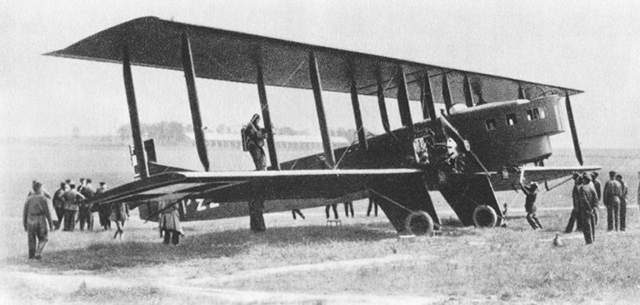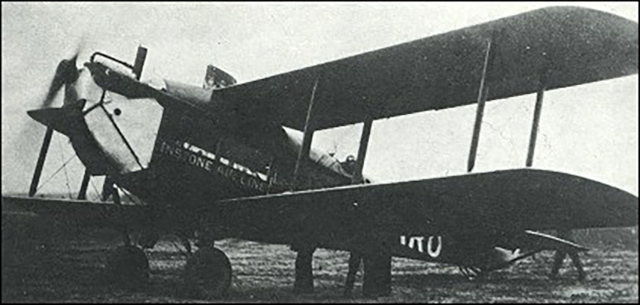The first midair involving a passenger carrying aircraft happened in 1922 and was considered to be a "series of tragic coincidences" that was unlikely to ever occur again. Or course history has proven that thought to be wrong.
— James Albright

Updated:
2014-03-26
Flying in general, and instrument flying in particular, depends on everyone following the same rule book to keep things safe. In 1922 the sky was considered big enough where these kinds of things were not thought of as critical. In fact, after this midair many thought it such a freak occurrence, that there was no need to change anything.
More about this: The Big Sky Theory.

1
Accident report
First Aircraft:
- Date: 7 April 1922
- Time: 14:00
- Type: Farman F-60 Goliath
- Operator: Compagnie des Grands Express Aeriens
- Registration: F-GEAD
- Fatalities: 2 of 2 crew, 3 of 3 passengers
- Aircraft Fate: Destroyed
- Phase: En route
- Airport: (Departure) Paris Le Bourget Airport (LBG/LFPB), France
- Airport: (Destination) London Croydon Airport, United Kingdom
Second Aircraft:
- Type: de Havilland DH-18A
- Operator: Daimler Hire Limited
- Registration: G-EAWO
- Fatalities: 2 of 2 crew, 0 of 0 passengers
- Aircraft Fate: Destroyed
- Phase: En route
- Airport: (Departure) London Croydon Airport, United Kingdom
- Airport: (Destination) Paris Le Bourget Airport (LBG/LFPB), France
2
Narrative
- The Goliath airplane belonging to the French Compagnie des Grands Express Aeriens, which left the Paris airdrome at noon today, carrying three passengers, a pilot and a mechanic collided at about 2 o'clock with an English airplane coming from London, carrying mails, but no passengers. All but one person on board both machines were killed.
- The catastrophe took place in a fog near Grandvilliers in the Oise Department. The machines burst into flames in the air.
- That two airplanes flying in opposite directions on the regular route between the two cities should by a series of tragic coincidences collide in the air seemed hardly creditable to most people. It is the first accident of the kind which has happened, and, despite the profound impression created by it, the chances of its recurrence seem so infinitely small that it is not likely to affect civilian flying on a route which daily safely transports many passengers and mails.
Source: The New York Times, 1922
3
Analysis
- Weather was marginal with low hanging cloud and fog and a light drizzling rain. As instrument flying was yet to be invented and formally instituted, both pilots were flying at the base of the cloud with reference to the ground, thereby unwittingly matching altitudes. At the time, an informal practice existed that one should offset from navigational landmarks based on the rules of the road, thus, a French pilot would fly up a roadway, offset to the right side and looking down on the road to the left. Opposing traffic therefore would pass also on the left. The same informal practice was done in England, though few considered the potential international conflict based on English roadway rules, cars had right hand drive and drove on the left side of the roads! Thus, the British pilot of the Daimler Airway flight naturally offset to the left, not to the right. This put the planes on a natural collision course with the cloud base dictating their identical altitude.
- In the wake of the accident, the world’s aviation authorities got together to discuss the matters at hand. A number of changes were recommended and approved. First and foremost, the midair collision resulted in a universal definition of “right of way” in the air, where planes should offset to the right when flying over roads or landmarks, that on seeing another aircraft approach head-on that they should each turn to the right to thereby avoid a collision and so forth. As critically, the accident spurred the creation of the world’s first airway systems, the same “highways in the sky” that we currently use today, combining lower altitude airways with the “J-routes” or jet airways of higher altitudes. Check points (usually at navigational aids) are connected by straight line airways between them, enabling aircraft separation by altitudes on the airways and conversely giving rise to the system of westerly headings on even altitudes (8,000 feet, 10,000 feet, etc.) and easterly headings on odd altitudes (9,000 feet, 11,000 feet, etc.).
Source: The First Midair Airline Disaster
4
Cause
Both crews were apparently trying to maintain visual contact with the ground while flying under a low overcast, and must have simply failed to see each other’s in time to prevent the accident. It was also reported that G-EAWO had been slightly to the left of the proper course, maybe due to the inexperience of the pilot on this line. Priority rules should be the same in aviation as on the road but in the present case, experts confirmed these rules were not the same in UK and France. So new priority rules will come into force following this tragic event.
Source: Bureau of Aircraft Accidents Archives
References
(Source material)
"Americans Die in French Air Crash," The New York Times, April 8, 1922.
Bureau of Aircraft Accidents Archives
The First Midair Airline Disaster, Flight Stories, 07 April 2013.

